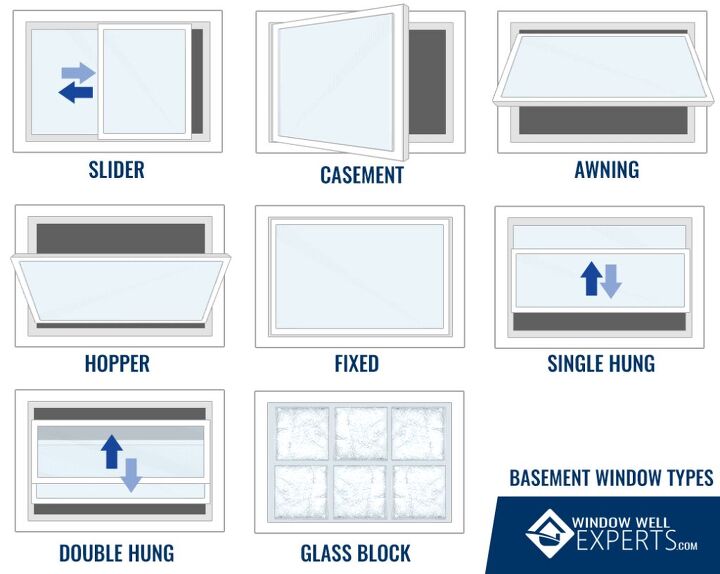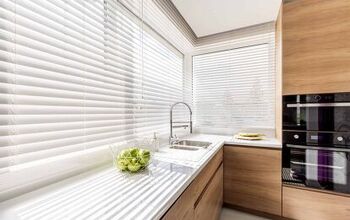10 Types of Basement Windows (with Photos)

Whether you’re looking for replacement windows for your basement or you need basement windows for new construction, you have many options to consider. Basements tend to suffer from poor lighting, which typically makes them very dark and gloomy. Although you can get creative with artificial lighting, few things will liven up a space quite like natural light.
If you are considering replacing your windows, get a quote from local contractors in your area here.
One of the most important factors involved in determining the best type of basement windows to use is the type of basement you have. Unfinished basements that are primarily used for storage likely won’t need a window that’s particularly fancy. Whereas, a finished basement that is used frequently will require you to be a bit more calculated about the windows that you choose.
In fact, if your basement has finished, habitable rooms, building codes require it to have egress windows, or windows that are big enough to escape through in case of an emergency. There are many different types of basement windows to choose from, some of which can allow for means of egress while others cannot. Some of the most popular basement windows include sliding windows, awning windows, casement windows, hopper windows, and fixed windows.
Whether finished, partially finished, or unfinished, the basement operates under different conditions than the rest of your home. As such, you’ll need to evaluate the unique needs and requirements of your particular space in order to find the right basement window system. Continue reading for our comprehensive guide on the different types of basement windows, so that you can make an informed decision on which are best for you and your home.
What is an Egress Window?
According to the International Residential Building Code (IRC), requires that basements and sleeping rooms beneath the first story of the house have at least one “emergency escape and rescue opening.” This opening can be a patio door, skylight, or window, with the main requirement being that it is big enough for someone to escape through and for emergency personnel to enter.
The IRC sets specific standards in terms of minimum height, width, and net clear opening. The way that the window is opened, along with the maximum distance from the floor is also administered by code. As long as windows meet the necessary requirements, the code does not dictate what type of basement window it must be. In order to meet the standards put in place by the IRC, egress windows must possess:
- A minimum opening height of 24 inches
- A minimum opening width of 20 inches
- A minimum net clear opening of 5.7 feet (which pertains to the free space present when the window is open, in other words, the size that individuals can crawl through)
- The bottom of the window has to be within 44 inches of the floor
- The window has to be functional from the inside and cannot be blocked with bars or grilles, or require tools or a key in order to open
Basement Egress Windows vs. Standard Basement Windows
Not all basement windows are considered egress windows. For example, if your basement is unfinished, it may simply have ventilation windows that likely don’t meet the requirements for egress windows. However, if your basement has finished, habitable spaces, building codes state that it must have egress windows, or some other means of egress (such as a patio door). Additionally, each basement bedroom, whether it’s pre-existing or added, must have egress windows.
Basement egress openings have stricter rules than egress openings in other areas of the home. Basement egress windows must:
- Have approximately nine square feet of open area
- Be able to open completely
- Have a minimum width and height of 36 inches
- Possess a permanently attached ladder or steps – if the window is over 44 inches off the floor
- The ladder has to be 12 inches in width, and no less than three inches out from the window well. Also, the open window cannot encroach or obstruct the open dimensions by over six inches.
- If the window is under a deck or porch, there has to be at least 36 inches between the bottom of the structural joists and the top of the window.
Although these requirements will satisfy the standards set by the IRC, each city and state code may vary slightly. With that said, before you build or look for a replacement window, get in touch with a local contractor to ensure you’re meeting the required standards for basement windows.
Types of Basement Windows
Whether you’re finishing your basement or renovating your basement, the windows are one of the most crucial parts of your project. Not only will the right basement windows improve the overall appearance of the space, they are also important to ensure safety and reducing the risk of moisture problems in your basement. With that said, here are some of the most common types of basement windows you have to choose from:
1. Slider Basement Windows
Slider, or sliding, windows are among the most common types of basement windows. They consist of two different sections, and slide open horizontally from either the left or the right. Similar to a sliding patio door, these windows move along a track. Depending on the size of the slider window, it may or may not meet the requirements of an egress opening. Based on egress standards, a slider window must be a minimum of 41 inches high in order to be considered an egress window.
Sliding windows are an excellent choice for basements that could use some natural lighting. They allow you to enjoy the full view of your yard, while also providing direct access to your backyard. You’ll also often hear these types of windows referred to as “horizontal single-hung” windows.
2. Fixed Basement Windows
Fixed basement windows are, as the name suggests, fixed in place. This means that they cannot open, slide, hinge. Glass block windows are technically a type of fixed basement window. As such, these windows do not allow for means of egress and are not recommended if your particular basement requires that you have egress windows.
3. Hopper Basement Windows
Of all the basement windows, hopper windows are the most popular and for good reason. For starters, they provide excellent ventilation for your basement. Hopper windows feature hinges on the bottom, allowing it to open downward and inwards as a whole unit which facilities excellent air flow and good natural lighting.
Hopper windows come in a variety of privacy options, including frosted and glass blocks. That way, no one can peek into your basement from the outside. These windows have a very basic design, are affordable, and easy to operate, making them a great go-to option for your basement. In terms of security, they may be easy to open, but they can be rather small and may not fit the standards of an egress opening.
4. Awning Basement Windows
Awning windows, on the other hand, are essentially the opposite of hopper windows. Instead of hinging at the bottom, these windows hinge at the top. The design causes the window panel to move outward from the house, producing an awning effect when opening. Like hopper windows, these are great for allowing sufficient airflow and natural light into your basement while also protecting your interior on rainy or snowy day.
Regardless of the weather, you can open your awning basement windows to let in a bit of fresh air. Depending on the size, an awning window may or may not allow for means of egress.
5. Casement/ Crank Basement Windows
Casement, or crank, windows are an excellent choice for above-ground basements. They are also commonly used in bathrooms, regardless of the floor they’re on. These types of windows can be found in one panel and two panel designs, hinging from either the left or the right. The dimensions of casement windows typically involve the height being greater than the width.
These windows are easily identifiable by the whole window opening outward. As their nickname suggests, many windows in this style are equipped with a crank handle that makes it easy to open the window from the side. If you need an egress window in your basement, casement windows are often a great choice.
6. Double Hung Basement Windows
Double hung windows consist of two panels that slide independently either vertically or horizontally to create an opening on both sides of the window. These types of windows provide sufficient sunlight and fresh air when needed. Some models can even be over five or six feet high, which isn’t usually ideal for a basement. As such, it’s often rare to see double hung windows or even casement windows in a basement, unless an egress opening is required.
7. Single Hung Basement Windows
Single hung windows are another popular style used in basements. Like their double hung counterparts, these windows feature two panels. They also provide ample natural lighting and air flow when opening, However, one panel is stationary while the other slides up and down. Single hung windows are essentially the vertical version of a slider basement window.
8. Glass Block Basement Windows
Glass block windows are an excellent choice for those prioritizing privacy in their basement. However, when you opt for these windows in your basement you typically have to be willing to sacrifice a view and the ability to open the window for ventilation. Glass block windows are constructed using solid glass that cannot be seen through from either the inside or the outside. When compared to traditional basement windows, they are much heavier.
Basement Window Frame Materials
The material of the frame that you choose for your basement windows will impact various factors including durability, heat transfer, and ease of maintenance.
- Vinyl is, arguably, the most popular choice for replacement windows. Vinyl windows are constructed out of impact-resistant polyvinyl chloride (PVC). They feature hollow chambers inside which makes them resilient against condensation and heat transfer. Vinyl is also a very low maintenance choice, as it doesn’t require finishing or painting and will not fade or rot over time.
- Wood is usually popular for the interior portions of a window, although you can still find windows made out of solid wood. When compared to other materials, wood doesn’t conduct heat or cold or facilitate condensation as much. However, it is susceptible to warping, expansion, contraction, fading, pest infestations, and rot. You can buy wood windows painted or unfinished, which allows for some flexibility and customization.
- Aluminum is usually a very economical material for replacement windows. They are lightweight, durable, and fairly easy to handle. Aluminum basement windows also require minimal maintenance and are resistant to corrosion.
- Fiberglass offers durability and water resistance. These windows won’t bend, peel, warp, rust, crack, or corrode. They are very long-lasting and easy to maintain. Since they have lower thermal expansion and heat conductivity, fiberglass window frames won’t expand or contract as much as alternative materials.
- Clad-wood windows offer all the advantages of wood on the interior, but the exterior is shielded in durable, low-maintenance aluminum material. This cladding makes the windows stronger and resistant to rot.
Although many original basement windows are made from wood, it usually doesn’t make sense to opt for wood for a replacement window unless you have a specific reason. With that said, vinyl is often the go-to choice for basement window frames, whether it’s finished or unfinished.
Final Thoughts
The type and material of basement window that you choose ultimately comes down to whether your basement is finished or unfinished. For unfinished basements, the space is likely only used for housing your heating and cooling systems, as additional storage space, or a laundry room. In this case, you still want to choose quality windows but you likely don’t need to choose windows with the highest energy star rating, additional design features, or windows that allow means of egress.
Finished basements, on the other hand, require that you consider more factors. Aside from safety and the possibility of an egress window required by code, efficiency and aesthetics are important decisions you’ll have to make. Since you’ll likely be spending a considerable amount of time in your finished basement, you want windows that are energy-efficient and visually pleasing.
UpgradedHome participates in affiliate programs. When you purchase through our links, we may earn a commission.

Jessica considers herself a home improvement and design enthusiast. She grew up surrounded by constant home improvement projects and owes most of what she knows to helping her dad renovate her childhood home. Being a Los Angeles resident, Jessica spends a lot of her time looking for her next DIY project and sharing her love for home design.
More by Jessica Stone



































